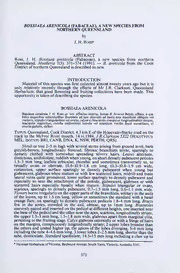Table Of ContentBOSSIAEAARENICOLA (FABACEAE), A NEW SPECIES FROM
NORTHERN QUEENSLAND
by
J. H. Ross»
ABSTRACT
Ross, J. H. Bossiaea arenicola (Fabaceae), —a new species from northern
Queensland. Muelleria 7(3): 371-374 (1991). B. arenicola from the Cook
District ofnorthern Queenslandisdescribedas new.
INTRODUCTION
Material ofthis species was first collected almost twenty years ago but it is
only relatively recently through the efforts of Mr J.R. Clarkson, Queensland
Herbarium, that good flowering and fruiting collections have been made. This
opportunityis taken ofdescribingthe species.
BOSSIAEAARENICOLA
Bossiaea arenicolaJ. H. Rosssp. nov. affinitas incerta, forsan B. brownii Benth. affinis, aqua
foliis majoribus orbicularibus rhombeis ad late obovatis ad basin non manifeste obliquis vel
cordatis,stipulistriangularibusvelovatis,calyceetbracteolisconspicuelonatudinaliterstriatis,
bracteolis majoribus, corolla uniformiter luteola vel interdum vexillo fauce aurantiaco, et
ovariisglabriis,differt.
Typus: Queensland, CookDistrict, 4.3 km Eofthe Hopevale-Starke road on the
track to the Mclvor River mouth, 14.vi.l984, J.R.Clarkson 5322 (HolotypuS:
MEL; ISOTYPI: BRI, CANB, DNA, K, NSW, PERTH, QRS).
m
Shrub or tree 2-5 high with several stems arising from ground level; bark
greyish-brown, lon^tudinally fissured, fibrous; branchlets terete, sparin^y to
densely clothed with somewhat spreading silvery hairs. Leaves alternate,
distichous, unifoliolate, reddishwhenyoung, on shortdenselypubescentpetioles
mm
1.5-3 long; leaflets orbicular, rhombic and sometimes transversely so, to
broadly ovate or obovate, (0.6-)0.9-1.8 cm long, (0.5-)0.8-1.9 cm wide,
coriaceous, upper surface sparin^y to densely pubescent when young but
glabrescent, glabrous when mature or with few scattered hairs, midrib and main
lateral veins quite prominent, lower surface sparingly to densely pubescent and
especially so near the attachment of the petiole, ^abrescent, ^abrous or with
scattered hairs especially basally when mature. Stipules triangular or ovate,
mm mm
scarious, sparingly to densely pubescent, 0.7-1.5 long, 0.6-1.1 wide.
Flowersborneirregularlyontheupperpartsofthebranchlets, solitaryintheaxils
ofthe leaves, up to 1.5 cm long, yellow or sometimes the standard with a basal
mm
orange flare, on sparingly to densely pubescent pedicels 1.8-4 long. Bracts
few in the series, crowded in the axil, obtuse, up to 1mm long. Bracteoles
unevenlypairedandinsertedonthepedicelatdifferentheights, oneinsertednear
thebaseofthepemdimcelandtheothermnmeartheapex, scarious, longitudinallystriate,
the upper 1.3-3 long, 1.5-1.8 wide, glabrous apart from marginal cilia,
persisting to the fruiting stage. Calyxglabrous externally orwith a fringe ofhairs
on the margins, conspicuously longitudinally striate; 2 upper lobes broader than
mm
the others and united higher up, the apices ofthe lobes diverging, 5-6 long
mm mm
includingthetube 4-4.6 long, 3 lowerlobes 2-2.5 long, shorterthan the
mm
tube, denticulate. Standardspathulate, 14.5-15 long including a claw up to
*NationalHerbariumofVictoria,BirdwoodAvenue,SouthYarra,Victoria,Australia3141.
371
372
— —
Fig. 1.—Bossiaeaarenicola.—a floweringtwig,—x1.b calyxop—enedout(upperlobesonright), x4.—c
standard, x3.d— wingpetal, x3.e —keelpetal, x3.f staminaltubeopenedout, x3.g
gfyrnoomeJc.iRu.m,Clxa3r.kshon54f7r6u.itingtwig, xI. i seed, sideview, x5. a-hfromJ.R. Clarkson5322, i
)
373
mm mm
5.5 long, 10.5-13 wide, claw with two calli near the apex; wing petals
mm mm mm
11-13 long including a claw 3-3.8 long, 3-3.4 wide; keel petals
mm
shorter than or longer than the wings, 12.8-13.6 long including a claw up to
mm mm mm
3.8 long, 4.3-4.9 wide. Stamen-filaments 9.6-14.5 long. Ovary 4-
mm
4.5 long, densely clothed with silvery antrorse hairs, 2-4-ovulate, on a stipe
mm
3-5.2 long, the stipe glabrous basally but densely pubescent above; style
mm
6-6.5 long. Podsoblongoroblong-elliptic, onastipewhichexceedsthecalyx,
1.6-2.2cm long, 0.9-1.3 cm wide, transverselyvenose, glabrousorwith scattered
hairsonthe marginsandsurface, coriaceous, marginsthickened, dehiscent. Seeds
mm mm
transversely ellipsoid, 3.4-3.5 long, 4.4-4.5 wide, uniformly yellowish-
brownbut only immature seeds seen, with a hoodedcap-like aril. (Fig. 1
B. arenicola has a fairly wide but disjunct distribution on the eastern side of
the Cape York Peninsula between latitudes iri2'S and 15°20'S. It is recorded
from Logan Jack Creek in the north southwards to Shelburne Bay, Olive River,
Cape Flattery, Cape Bedford and the vicinity ofHopevale (NW ofCooktown).
The species is recorded growing on wind blown sands, on dunes and on river
banks in wooded or closed heath, in dense shrubby communities overtopped by
scattered trees or shrubs and in rainforest.
Representative Specimens (10 specimens examined):
—
Queensland CookDistrict,nearLoganJackCreek,2.viii.1987,H. Gitay108(BRI);coastSof
ThorpePoint, ShelburneHoldings, 27.xi.1985W,A. Gunness 1964(BRI);OliveRiver, 14. ix.l974,LJ.
Webb & J.G. Tracey 13610 (BRI); 11.9 km ofthe Hopevale to Starke road on the track to the
MclvorRivermouth, 14.viii.l984,J.R. Clarkson5476(BRI,MEL,QRS).
NOTES:
The affinities ofB. arenicola are not entirely clear. The species is perhaps
allied to B. brownii Benth. but differs in having larger orbicular, rhombic (and
sometimes transversely so) to broadly ovate or obovate leaflets which are not
obviously oblique or cordate basally, triangular or ovate stipules, conspicuously
longitudinally striate calyces and bracteoles, a uniformly yellow corolla or the
standard sometimeswith an orange basal flare, andglabrous ovaries.
B. arenicola cannot be accommodated in any of the Series recognized by
Bentham (1864). Onaccountofthedenselypubescentovariesthe speciesfitsinto
Bentham’sEriocarpaebut, atthe sametime, the lackofhairy podsandthenature
ofthe uppercalyx lobesexclude itfromthe Series. The denselypubescent ovaries
exclude the species from the Series Normales.
B. arenicola has 2-4 ovules, a feature shared with B. foliosa Cunn. and B.
oligosperma A. Lee. Each of the two latter species has much smaller and
differently shaped leaves. Although the ovary in B.foliosa is densely pubescent,
the hairs are ferruginous, whereas the ovary in B. oligosperma is glabrous. The
ecological preferences and distributional ranges ofB.foliosa and B. oligosperma
are quite different to those of B. arenicola and the species are unlikely to be
confused.
B. arenicola is distinguished atonce from B. rupicola andB. carinalisin that
the keel petals are shorterthan the standard.
B. arenicola favours sandy situations, whence the specific epithet.
ACKNOWLEDGEMENTS
I am most grateful to John Clarkson, Queensland Herbarium, for making
special collections ofthis species; to my colleague Anita Barley for executing the
illustration which accompanies this paper; to Alex George, Executive Editor of
the Flora ofAustralia, for checking the Latin diagnosis; and to the Director and
CuratorofBRI andQRS respectively forthe loan ofspecimens.
374
REFERENCE
Bentham,G.(1864)‘FloraAustraliensis’. 2; 154-168.(LovellReeve&Co.: London.)
Manuscriptreceived5February 1990;revised7May 1990.

